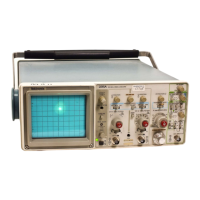Operating Instructions—2215A Service
level difference is more than 10 times the VOLTS/DIV
switch setting:
1. Set the Input Coupling switch to GND.
2. Insert the probe tip into the oscilloscope GND connec
tor and wait several seconds for the input coupling capacitor
to discharge.
3. Connect the probe tip to the signal source and wait
several seconds for the input coupling capacitor to charge.
4. Set the Input Coupling switch to AC. The display will
remain on the screen, and the ac component of the signal
can be measured in the normal manner.
OPERATOR’S ADJUSTMENTS
INTRODUCTION Horizontal
To verify the operation and accuracy of your instrument
before making measurements, perform the following
adjustment procedures. Adjustments beyond the scope of
"Operator’s Adjustments” are in the “Adjustment
Procedure” Section 5 of this manual.
Before proceeding with these instructions, refer to
"Preparation for Use” in this section for first-time start-up
considerations.
A/B SWP SEP
POSITION
HORIZONTAL MODE
A and B SEC/DIV
SEC/DIV Variable
X I0 Magnifier
B DELAY TIME POSITION
Off midrange
Midrange
A
0.5 ms
CAL detent
Off (knob in)
Fully counterclockwise
B TRIGGER
SLOPE OUT
LEVEL Fully clockwise
Verify that the POWER switch is OFF (push button out),
then plug the power cord into the power-source outlet.
BASELINE TRACE
A TRIGGER
VAR HOLDOFF
Mode
SLOPE
LEVEL
A&B INT
A SOURCE
A EXT COUPLING
NORM
P-P AUTO
OUT
Midrange
VERT MODE
INT
AC
First obtain a baseline trace, using the following
procedure.
1. Preset the instrument front-panel controls as follows:
Display
A and B INTENSITY Fully counterclockwise
FOCUS Midrange
2. Press in the POWER switch button (ON) and allow the
instrument to warm up (20 minutes is recommended for
maximum accuracy).
3. Adjust the A INTENSITY control for desired display
brightness.
Vertical (Both Channels)
POSITION
VERTICAL MODE
BW LIMIT
VOLTS/DIV
VOLTS/DIV Variable
INVERT
Input Coupling
Midrange
CH 1
Off (button out)
50 mV
CAL detent
Off (button out)
AC
4. Adjust the Vertical and Horizontal POSITION controls
as needed to center the trace on the screen.
TRACE ROTATION
Normally, the resulting trace will be parallel to the center
horizontal graticule line, and the Trace Rotation adjustment
2-9

